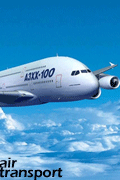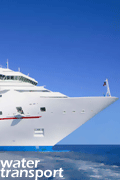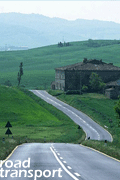|
WASHINGTON - Maryland's plans for congestion relief near Washington, D.C., got a boost from the U.S. Department of Transportation through its approval of a $516 million loan for the Inter-County Connector.
"The ICC will make the commute easier for drivers who suffer each day through some of the most congested highways in the nation," said Federal Highway Administrator Tom Madison.
The loan will help the Maryland Transportation Authority build the ICC, an 18-mile, six-lane limited access toll highway linking Prince George's and Montgomery counties. ICC tolls will vary according to traffic levels throughout the day, and drivers will pay tolls electronically to avoid waiting at tollbooths.
The ICC will also connect the I-270 and I-95/US 1 highways in the two counties where no contiguous high-capacity facility exists to accommodate east-west travel and local roads are experiencing extremely high traffic volumes.
"Open road, variable electronic toll roads are clearly the wave of the future," said Madison. "By using prices to manage capacity for this road, we can ensure that it never becomes congested."
The Maryland Transportation Authority will secure the loan and repay it with revenue from a number of toll facilities throughout Maryland, in addition to revenue generated by the ICC.
Flexible loan terms available through TIFIA make it possible to finance a broad variety of projects. The ICC loan is one of the largest ever made under the TIFIA program. The total cost for the project, estimated at more than $2.5 billion, will be funded also through GARVEE and other revenue bonds and state funds.
Madison added that the project was a priority project under the President's Executive Order on Environmental Streamlining and Stewardship. It is also one of the longest planned road projects in U.S. history.
              
posted by transport blogs
@ 9:10 PM
permanent link |
|

The Federal Railroad Administration (FRA) is moving forward with developing new rules that prescribe how railroads should implement Positive Train Control (PTC) systems to prevent train-to-train collisions, announced FRA Acting Administrator Clifford C. Eby.
"We are acting quickly and without delay because railroads will need guidance on how to create plans to deploy PTC systems by the end of 2015," Eby said, noting the first deadline mandated by Congress in a new rail safety law is April 2010, when major freight railroads and intercity and commuter rail operators must submit their PTC implementation plans to FRA for approval.
Eby stated that developing the new rules is a necessary first step to specify how the technically complex PTC systems must function and to describe how FRA will assess a railroad's PTC implementation plan before it can become operational. He added FRA is already working with its Railroad Safety Advisory Committee to identify key issues and will release a recommendations report by next April.
In addition, FRA is coordinating efforts with the Federal Communications Commission to make available a sufficient amount of radio frequency spectrum essential for PTC technology to function properly as it sends and receives a constant stream of wireless signals about the location and speed of passenger and freight trains moving along rail lines. FRA also is working closely with Metrolink, the Union Pacific Railroad, and the BNSF Railway to accelerate the deployment of PTC in the Los Angeles area by the end of 2012, Eby emphasized.
"I am encouraged that the major freight railroads have reached agreement for the interoperability of PTC technology across different rail systems," said Eby, stressing that resolving this key technical challenge will facilitate PTC implementation industry-wide.
PTC technology is capable of automatically controlling train speeds and movements if a locomotive engineer fails to take appropriate action. For example, it can bring a train to a stop before it passes a red signal to avert a potential collision. Other benefits of PTC systems include prevention of over-speed derailments and unauthorized incursions by a train into work zones.
Eby also noted that FRA has done extensive PTC-related technical research in recent years and significantly revised federal signal and train control regulations to support development of the safety technology.
For more information about the development of new PTC rules, visit
http://www.fra.dot.gov/downloads/Summary%20of%20Implemention%20of%20PTC%20Systems%20(December%202008).pdf
              
posted by transport blogs
@ 8:36 PM
permanent link |
|

posted by transport blogs
@ 9:17 PM
permanent link |
|

posted by transport blogs
@ 8:46 PM
permanent link |
|

LOS ANGELES - U.S. Secretary of Transportation Mary E. Peters announced today that Los Angeles will receive $210 million in federal funds to help cut highway traffic jams and provide better bus transit services in Los Angeles. It is the largest congestion grant the Department has awarded to any city to date, the Secretary said.
The Secretary said the funding will allow local leaders to move forward with a plan to convert existing HOV lanes to High-Occupancy Toll lanes and implement congestion pricing to improve southern California's traffic, air quality, and quality of life.
"Los Angeles' willingness to try something new will mean less traffic, better transit and a cleaner environment," Secretary Peters said.
Los Angeles Partners will pay for state of the art tolling technology to allow drivers to pay a fee for access to less-congested lanes and sophisticated sensors that will monitor the region's freeways and adjust fares for the lanes based on traffic levels. The Los Angeles Partners are the Los Angeles County Metropolitan Transportation Authority and the California Department of Transportation. The project includes HOV-to-HOT conversions on the following facilities: I-10 from Alameda Street to I-605 (28 lane-miles), and I-110 from 182nd Street/Artesia Transit Center to Adams Blvd (33 miles).
The Secretary said transit service in Los Angeles will also improve. The money will finance new bus service and park-and-ride facility improvements. "HOT lanes benefit commuters whether they are taking transit or driving. Transit riders benefit from both quicker commutes and increased transit investments from pricing revenues," Secretary Peters said.
The Los Angeles investment is a part of the Department's comprehensive initiative to address congestion throughout the nation's transportation system. In addition to Los Angeles, the Department has entered into partnerships with Chicago, Miami, Minneapolis, San Francisco, Atlanta, and Seattle.
A copy of the Memorandum of Understanding is available at: http://www.dot.gov/affairs/Agreement.htm
              
posted by transport blogs
@ 9:22 PM
permanent link |
|

posted by transport blogs
@ 9:12 PM
permanent link |
|

By law, you must wear a seat belt in cars and goods vehicles where one is fitted. There are very few exceptions to this. The driver is liable to prosecution if a child under 14 years does not wear a seat belt or child restraint as required.
Children up to 135cms tall must use the appropriate child restraint for their weight (not age) when travelling in the front or back seat of any car, van or goods vehicle. There are very few exceptions. Read more about child car seats. 'Child restraint' means any of baby seat, child seat, booster seat or booster cushion.
A child can use an adult belt when they reach 135cm or their 12th birthday, whichever comes first.
In buses and coaches with seat belts fitted, passengers aged 14 years and above must use them. Passengers on vehicles used for public fare paying passengers on 30mph roads are exempt.
| The law for cars, vans and other goods vehicles is summarised in this at-a-glance table. |
|
Front seat |
Back seat |
Who is responsible |
Driver |
Seat belt must be worn if fitted |
|
Driver |
Child up to three years of age |
Correct child restraint must be used |
The correct child restraint must be used. If one is not available in a licensed taxi/private hire vehicle, the child may travel unrestrained. |
Driver |
Child from third birthday up to 135cms in height (approx 4'5") or 12th birthday, whichever is reached first |
Correct child restraint must be used |
Where seat belts are fitted, the correct child restraint must be used.
The child must use an adult belt in the back seat if the correct child
restraint is not available either:
- In a licensed taxi or private hire vehicle.
- For a short distance in an unexpected necessity.
- If two occupied child restraints prevent fitting of a third.
A child three years and over may travel unrestrained in the back seat
of a vehicle if seat belts are not fitted in the rear. |
Driver |
Child 12 or 13, or over 135 cms (approx 4' 5") in height |
Seat belt must be used if fitted. |
Seat belt must be used if fitted. |
Driver |
Passengers aged 14 years and over |
Seat belt must be worn if fitted |
Seat belt must be worn if fitted |
Passenger |
|
Top tips Don't
Put the same seat belt around two children, or around yourself and another passenger (adult or child). In a crash, they will crush each other. let a child use an adult belt too early.
              
posted by transport blogs
@ 8:51 PM
permanent link |
|

posted by transport blogs
@ 9:29 PM
permanent link |
|

Take time to practice before driving on main roads and never allow anyone to ride in or on the trailer. Before you leave, remember to check routes and restrictions on bridges and tunnels. Consider the following safety tips each time you drive with a trailer. General Handling- Use the driving gear that the manufacturer recommends for towing.
- Drive at moderate speeds. This will place less strain on your tow vehicle and trailer. Trailer instability (sway) is more likely to occur as speed increases.
- Avoid sudden stops and starts that can cause skidding, sliding, or jackknifing.
- Avoid sudden steering maneuvers that might create sway or undue side force on the trailer.
- Slow down when traveling over bumpy roads, railroad crossings, and ditches.
- Make wider turns at curves and corners. Because your trailer’s wheels are closer to the inside of a turn than the wheels of your tow vehicle, they are more likely to hit or ride up over curbs.
- To control swaying caused by air pressure changes and wind buffeting when larger vehicles pass from either direction, release the accelerator pedal to slow down and keep a firm grip on the steering wheel.
Braking - Allow considerably more distance for stopping.
- If you have an electric trailer brake controller and excessive sway occurs, activate the trailer brake controller by hand. Do not attempt to control trailer sway by applying the tow vehicle brakes; this will generally make the sway worse.
- Always anticipate the need to slow down. To reduce speed, shift to a lower gear and press the brakes lightly.
Acceleration and Passing - When passing a slower vehicle or changing lanes, signal well in advance and make sure you allow extra distance to clear the vehicle before you pull back into the lane.
- Pass on level terrain with plenty of clearance. Avoid passing on steep upgrades or downgrades.
- If necessary, downshift for improved acceleration or speed maintenance.
- When passing on narrow roads, be careful not to go onto a soft shoulder. This could cause your trailer to jackknife or go out of control.
Downgrades and Upgrades - Downshift to assist with braking on downgrades and to add power for climbing hills.
- On long downgrades, apply brakes at intervals to keep speed in check. Never leave brakes on for extended periods of time or they may overheat.
- Some tow vehicles have specifically calibrated transmission tow-modes. Be sure to use the tow-mode recommended by the manufacturer.
Backing Up - Put your hand at the bottom of the steering wheel. To turn left, move your hand left. To turn right, move your hand right. Back up slowly. Because mirrors cannot provide all of the visibility you may need when backing up, have someone outside at the rear of the trailer to guide you, whenever possible.
- Use slight movements of the steering wheel to adjust direction. Exaggerated movements will cause greater movement of the trailer. If you have difficulty, pull forward and realign the tow vehicle and trailer and start again.
Parking - Try to avoid parking on grades. If possible, have someone outside to guide you as you park. Once stopped, but before shifting into Park, have someone place blocks on the downhill side of the trailer wheels. Apply the parking brake, shift into Park, and then remove your foot from the brake pedal. Following this parking sequence is important to make sure your vehicle does not become locked in Park because of extra load on the transmission. For manual transmissions, apply the parking brake and then turn the vehicle off in either first or reverse gear.
- When uncoupling a trailer, place blocks at the front and rear of the trailer tires to ensure that the trailer does not roll away when the coupling is released.
- An unbalanced load may cause the tongue to suddenly rotate upward; therefore, before un-coupling, place jack stands under the rear of the trailer to prevent injury.
              
posted by transport blogs
@ 1:19 AM
permanent link |
|

WASHINGTON - The Federal Motor Carrier Safety Administration (FMCSA) today took new steps toward improving standards and setting uniform requirements for medical examiners, while also finalizing a streamlined process for combining the commercial drivers license (CDL) and medical certificate records for commercial truck and bus drivers operating on the nation's roads.
"While we have made significant improvements in motor carrier safety, these actions will support and strengthen our continuing commitment to ensure that only medically qualified individuals are allowed to operate an interstate truck or bus. Safety is our paramount responsibility," FMCSA Administrator John H. Hill said.
FMCSA today issued a final rule that will require states to merge the commercial driver's license (CDL) and the driver's medical examination certificate into a single electronic record. When fully implemented by the states in three years, the new combined CDL will streamline record keeping obligations for the states and CDL holders, while providing instant electronic access to the CDL holder's medical certificate by state and federal enforcement officials.
In addition, the rule requires states to take enforcement actions against CDL holders if they do not provide medical certification status information within the deadline.
FMCSA today also issued a related rulemaking that would establish a National Registry of Certified Medical Examiners to ensure that physical qualification examinations of CDL holders are performed by qualified medical practitioners and are administered in a uniform and consistent manner. The Notice of Proposed Rulemaking (NPRM) for the National Registry of Certified Medical Examiners would create certification standards, including a training and testing program, and a National Registry of medical examiners who are qualified to conduct examinations of interstate truck and bus drivers.
The proposal would require the medical examiner to electronically transmit to FMCSA the name and a numerical identifier for each driver who is examined. The proposal also would create a process by which medical examiners who fail to meet or maintain the minimum standards would be removed from the National Registry.
The NPRM for the National Registry of Certified Medical Examiners can be found at www.regulations.gov, docket number FMCSA-2008-0363. Public comments on the proposal should be submitted by January 30, 2009.
The final rule on Medical Certification Requirements as Part of the CDL is available for review at www.fmcsa.dot.gov.
              
posted by transport blogs
@ 8:58 PM
permanent link |
|

|
![]()
![]()








